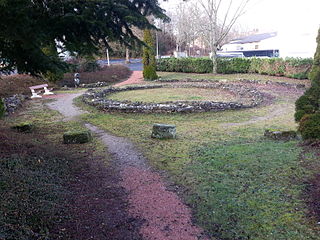 W
WAncient Celtic religion, commonly known as Celtic paganism, comprises the religious beliefs and practices adhered to by the Iron Age people of Western Europe now known as the Celts, roughly between 500 BCE and 500 CE, spanning the La Tène period and the Roman era, and in the case of the Insular Celts the British and Irish Iron Age. Very little is known with any certainty about the subject, and apart from documented names, which are thought to be of deities, the only detailed contemporary accounts are by hostile Roman writers, who were probably not well-informed.
 W
WBrigid, Brigit or Bríg is a goddess of pre-Christian Ireland. She appears in Irish mythology as a member of the Tuatha Dé Danann, the daughter of the Dagda and wife of Bres, with whom she had a son named Ruadán.
 W
WFanum d'Aron is a fanum, or Romano-Celtic temple, located in Aurillac, a French commune in the Auvergne region.
 W
WHuman sacrifice is the act of killing one or more humans as part of a ritual, which is usually intended to please or appease gods, a human ruler, an authoritative/priestly figure or spirits of dead ancestors, as a retainer sacrifice when a king's servants are killed in order for them to continue to serve their master in the next life. Closely related practices found in some tribal societies are cannibalism and headhunting.
 W
WLe Mormont is a hill in the Swiss canton of Vaud, rising to an elevation of 605 metres, with a prominence of about 115 metres. It is part of the Éclépens municipality between lakes Neuchatel and Geneva. The name is first recorded in AD 814, as Mauromonte. It is derived from the Roman-era personal name Maurus.
 W
WA nemeton was a sacred space of ancient Celtic religion. Nemeta appear to have been primarily situated in natural areas, and, as they often utilized trees, they are often interpreted as sacred groves. However, other evidence suggests that the word implied a wider variety of ritual spaces, such as shrines and temples. Evidence for nemeta consists chiefly of inscriptions and toponymy or place-names, which occur all across the Celtic world. Toponyms related to the word nemeton occur as far west as Galicia in the Iberian peninsula, as far north as Scotland, and as far east as central Turkey. The word is related to the name of the Nemetes tribe living by the Rhine between the Palatinate and Lake Constance in what is now Germany, and their goddess Nemetona.
 W
WAcropolis Roquepertuse is a historical religious center for the Celts. It is located near the city of Velaux, north of Marseille and west of Aix-en-Provence, in the Provence-Alpes-Côte d'Azur région of southern France. Roquepertuse had no domiciles available for worshippers and has been used as a sanctuary where only priests may have lived permanently. It was destroyed by the Romans in 124 BC and was discovered in 1860. Most of the excavations were done in 1923 by Henri de Gérin-Ricard.
 W
WThe "Temple of Janus" is a Romano-Celtic religious structure located in Autun, Saône-et-Loire, France, to the North-West of the ancient city of Augustodunum.
 W
WThe Temple "of Mars" is the vestige of a Romano-Celtic fanum and its courtyard, located in Corseul, in the department of Côtes-d'Armor, France.
 W
WThe Temple of Mercury at Puy de Dôme is a Gallo-Roman trachyte temple built in the 2nd century at the summit of the dome. It replaced a 1st-century arkose temple on the same site, which was apparently too small to accommodate the many pilgrims who visited. Its remains were revealed by excavation campaigns in 1875 and at the turn of the century.
 W
WThe Tower of Vesunna is the vestige of a Gallo-Roman fanum (temple) dedicated to Vesunna, a tutelary goddess of the Petrocorii. The sanctuary was built in the 1st or 2nd century. Vesunna was the Gallo-Roman name for Périgueux, in the Dordogne department, in the Nouvelle-Aquitaine region.